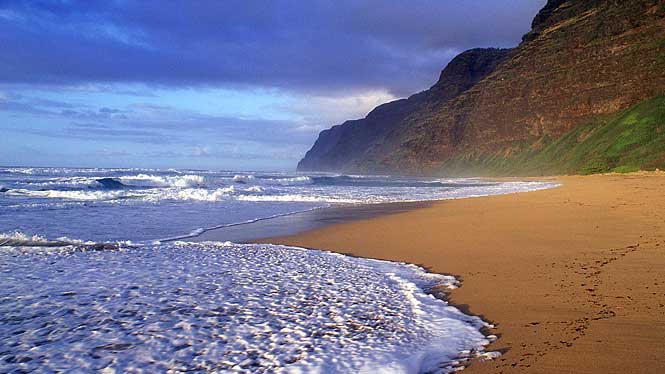
I stand on Polihale Beach, with miles of white sand beach stretching to my left, and more miles of pristine coastline to my right. Standing tiny and insignificant amidst the broad expanse of cliffs and beach, the sky melding into the ocean at an invisible horizon, I’m clearly aware that this area’s spiritual essence is in tune with the physical landscape.
At the very end of the road on Kauai’s southwest side at the end of the highway is a long dirt road that leads to one of Kauai’s most spectacular beaches called Polihale. The long stretch of white sand at Polihale is up to 100 yards wide providing plenty of room to relax. On the southern end of the park is an area of Polihale known as Queen’s Pond which is encircled by a coral reef that creates a relatively calm swimming area. Polihale’s sand dunes are up to 100 feet high in some places.
Archaeology
The combination of rough ocean conditions and a harsh, arid landscape left Polihale, located on Kauai, sparsely populated in ancient times. Still, several Hawaiian habitation sites and cave shelters have been discovered in the brush-filled valleys near Polihale; small groupings of grass houses bordered the foothills in a few areas, and simple stone enclosures mark sites where fishing camps were set up in the dunes centuries ago.
The major archaeological feature at Polihale is a Hawaiian temple, or heiau, located near the northern end of the beach. William C. Bennet visited the heiau during his round-the-island survey in 1928 and described the temple as a four-terraced structure 25-30 yards wide, with walls eight feet thick.
History
In centuries past, the Mana plains between Polihale Beach and the nearby mountain cliffs featured a huge marsh covering as much as 2,000 acres. The wetland would expand with the winter rains, and shrink to a much smaller size during the summer droughts. Some of the marshlands were used for rice farming in the mid-1800s and later drained for sugar cane. In recent years, canefields were converted to corn, sunflowers, cotton, and other crops.
Today
A 12-acre portion of the coastal plain at Mana is being mined for another valuable crop: sand. Local construction companies have been given permits to remove sand, resulting in the formation of natural ponds. The result is Kawaiele, a new State Waterbird Refuge for Hawai’i’s four endangered waterbird species.
Local fishermen and surfers often drive their 4-WD vehicles down the beaches, checking the water conditions that vary greatly with the prevailing swells. Excellent surfing spots are found along the coastline, but currents and undertows make swimming here quite dangerous.
Polihale State Beach Park is found at the end of the road in West Kauai, with access over several miles of potholed canefield roads. Limited picnic and camping facilities are available, although campers are required to get a permit from the State Building in Lihu’e.
The long stretch of white sand at Polihale is up to 100 yards wide providing plenty of room to relax. On the southern end of the park is an area of Polihale known as Queen’s Pond which is encircled by a coral reef that creates a relatively calm swimming area. Polihale’s sand dunes are up to 100 feet high in some places.
Great For
Sunbathing, fishing, beach walks. Swimming at Queen’s Pond. Only swim at Polihale when the water is calm and always stay close to shore. Surfing at Polihale is for those who are experienced only.
Highlights
Together Polihale and Barking Sands form Hawaii’s longest beach, spanning some 17 miles. Polihale State Park encompasses about 140 acres and is located at the northwestern end of this expansive beach. The northern end of Polihale Beach is the beginning of the world-famous Na Pali Coast. South of Polihale is the Pacific Missile Range Facility. Polihale can be very hot with limited shade so bring plenty of food and water. A beach umbrella is also recommended. The dunes near here have been named Barking Sands because they are said to make barking sounds due to the unique shape of the sand granules. Polihale is a great place to watch the sunset.
Need to Know
Polihale is fully exposed to the open sea and subject to high surf and a very rough ocean. Rip currents often form along the shoreline creating hazardous conditions for swimming. Only go in the ocean at Polihale when it is very calm and always stay very close to shore. Queens Pond is the only safe area. Even when it appears calm, there still may be strong currents that can sweep you hundreds of yards down the beach in minutes. Never go into the ocean during times of high surf or rough seas, and remember that there is no rescue support in this remote area.
Lifeguard
No
Facilities
Restrooms, showers, picnic tables, picnic pavilions, campsites, drinking water.
Access
Polihale State Park is located on the northern end of Polihale Beach and is reached by following Hwy. 50 from Waimea toward the west until you reach the end of the paved road and the beginning of the dirt road (Old Mana Road). A 4-wheel-drive vehicle is recommended though not required for the rough 5-mile dirt road to Polihale. When you reach the sand dune area near the beach you can either turn right to get to the main park area or turn left to get to Queen’s Pond.
